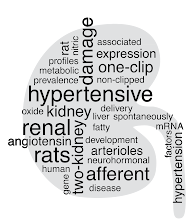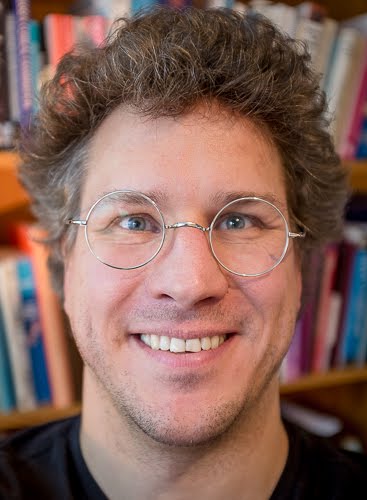I just attended the "National Kidney Conference" in Bergen. It was held in memory of Bjarne Iversen, my old mentor. Since the common denominator was that the presenters were old collaborators, the talks were very varied, or, you might say, the conference was a bit unfocused. Many did include a short presentation of how they had collaborated with Bjarne and tried to present data that in some way was connected to this, but equally many held their presentations as they would have at any other conference.
The highlights were Bill Arendshorst who talked about renal vascular function and Christos Chatziantoniou who talked about new markers and potential therapeutic targets in renal fibrosis. In addition Hans-Peter Marti presented data on markers of renal fibrosis on the genetic level. Personally, I had hoped for a wider attendance but I think the organizers wanted a more intimate meeting.
As with any meeting the important part was getting to meet some other experts in my field and discuss what we are and should be doing, and of course when and where we should meet next time to have a been and a chat. A bonus with invited lectures is that you get to aggregate your data and try to present them in a wider context. All-in-all a good meeting, although with a sad undertone as we remembered our mentor and friend who could not attend what was originally planned by him as a retirement seminar.
Sunday, March 25, 2012
Tuesday, March 13, 2012
Not so bad in Bad Gastein
I am in Bad Gastein for my mother's birthday. It is not the best place for a vacation if you can not ski. The town is slowly turning into a ghost-town. The center, or as our concierge put it not-much-of-a-center, includes a handful of kitsch-shops and some restaurants, non of which open before after-ski. These isolated shops are surrounded by old hotels, most empty and poorly kept. Supposedly it is too expensive to renovate them, and probably equally important, it makes no difference because everyone who come here now come here to ski. On the other hand, when the rest of the family is up on the slopes, there is no one to disturb me when I blog work and the WiFi is free.
Friday, March 09, 2012
Crossfit
I still do not have an anterior cruciate ligament, but with the suturing of the collateral ligament and some training the knee is surprisingly stable. As anyone can understand, the idea of keeping up with the young elite judoka at our club came to nothing. For this year anyway. Instead I have two gym cards, and I who have always considered gym-training the most boring training conceivable. Even worse than running, or even swimming.
First I have the subsidized membership at the hospital gym. It is a decent gym, mostly machines and a very cramped space for free-weight lifting. On the other hand it is easy to patch on 20 minutes of lifting before or after work (important), and they have a sauna (very important).
Second, an old friend of mine has started a crossfit gym in Uppsala, surprisingly named Crossfit Uppsala. Apparently it is the new hip thing for athletes to do, and the gym is also really good as far as crossfit-gyms go. When they started, some two (or three, even four) years ago, I shot some pictures for them. To my great satisfaction they still use them on their homepage.
Now they have over a hundred members and sell training-equipment to other gyms. The training is very varied and usually done in smallish groups with a leader (who may, or may not, drink coffee incessantly). If you are interested in more details about cross fit there are easily thousands of dedicated sites, just google it. Suffice to say I find it quite entertaining now that I cannot do judo for a while.
First I have the subsidized membership at the hospital gym. It is a decent gym, mostly machines and a very cramped space for free-weight lifting. On the other hand it is easy to patch on 20 minutes of lifting before or after work (important), and they have a sauna (very important).
 |
| Björn, combining single-handed push-ups with correcting his spectacles. I do not think they use this one on their homepage. |
Strength-wise I am as strong as I ever was. Today we did back-squats and my new personal best is 100kg. Quite good for not having an anterior cruciate ligament. Endurance-wise I was almost back before the influenza-epidemic hit, now I have some more catch-up to do. The knee is not stable enough for full-contact judo, but as soon as I get my surgery (not counting the following six months of rehab) I will be all set.
Wednesday, March 07, 2012
Identity-crisis
For many years now my plan was to establish myself as a researcher and then work my way into clinical nephrology, while continuing my research. Instead, I find myself at a crossroads. The department of nephrology at my hospital has no plans for another resident for at least two years, certainly not a combined research and clinical position. At the same time I have been offered just that in anaesthesiology and intensive care.
The research in medicine and nephrology is very much risk-factor based and focused on the progression of chronic disease, while intensive care is more focused on acute, homeostasis-based physiology. My research has connections to both areas: Acute regulation of renal blood flow on the one side, and more chronic progression of renal damage on the other. I can not say that I find either more enticing than the other.
So, my experimental research is about equally applicable in the two specialities, but the role as a doctor is completely different. In Sweden anaesthesiology is a service-speciality. That is, they keep the patient alive while the surgeons do their job. Intensive care is much the same, they maintain life-support while doctors from other departments are actually responsible for the diagnosis and treatment of the patient. Not that that may not be challenging or interesting in itself. It is just not the way I have looked at myself. On the other hand, practically everything in modern health-care are collaborations, and as intensivist you are really at the center of the treatment of the most critically ill patients. Sadly, it often means that the patients are not very talkative, and may not remember you at all.
In contrast, nephrologists get to diagnose and follow their patients through an often slowly progressing chronic disease. In short, they get to know their patients. In addition, the pace is decidedly slower, more measured, and the rounds longer, much, much longer.
At the moment, everything seems to head toward anaesthesiology and intensive care for me, while my self-image, and clinical practice so far has been focused on medicine and nephrology. Thus the identity-crisis.
The research in medicine and nephrology is very much risk-factor based and focused on the progression of chronic disease, while intensive care is more focused on acute, homeostasis-based physiology. My research has connections to both areas: Acute regulation of renal blood flow on the one side, and more chronic progression of renal damage on the other. I can not say that I find either more enticing than the other.
So, my experimental research is about equally applicable in the two specialities, but the role as a doctor is completely different. In Sweden anaesthesiology is a service-speciality. That is, they keep the patient alive while the surgeons do their job. Intensive care is much the same, they maintain life-support while doctors from other departments are actually responsible for the diagnosis and treatment of the patient. Not that that may not be challenging or interesting in itself. It is just not the way I have looked at myself. On the other hand, practically everything in modern health-care are collaborations, and as intensivist you are really at the center of the treatment of the most critically ill patients. Sadly, it often means that the patients are not very talkative, and may not remember you at all.
In contrast, nephrologists get to diagnose and follow their patients through an often slowly progressing chronic disease. In short, they get to know their patients. In addition, the pace is decidedly slower, more measured, and the rounds longer, much, much longer.
At the moment, everything seems to head toward anaesthesiology and intensive care for me, while my self-image, and clinical practice so far has been focused on medicine and nephrology. Thus the identity-crisis.
Subscribe to:
Posts (Atom)


